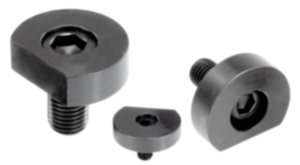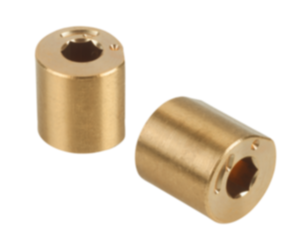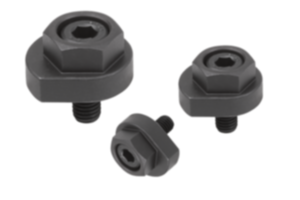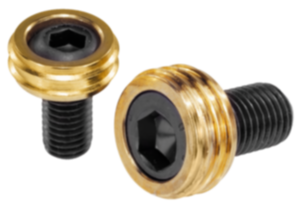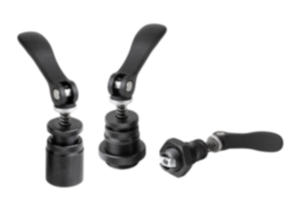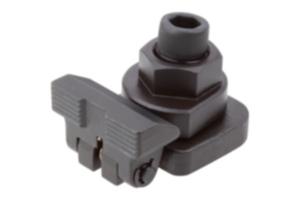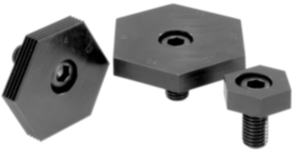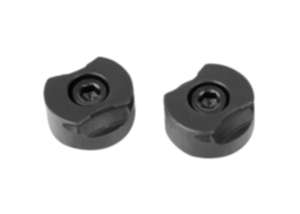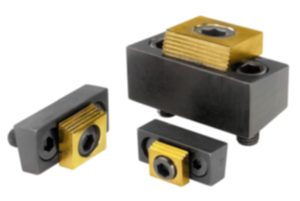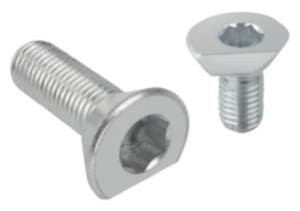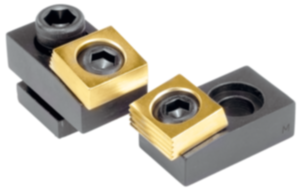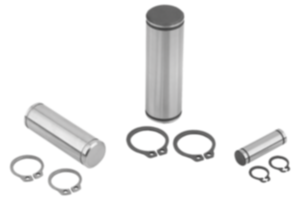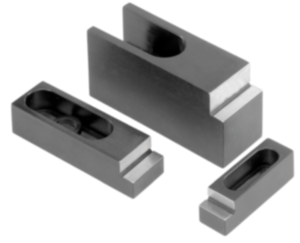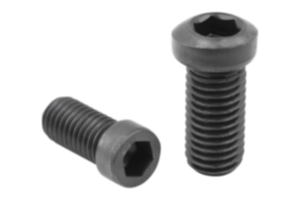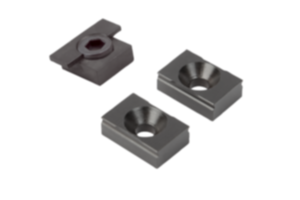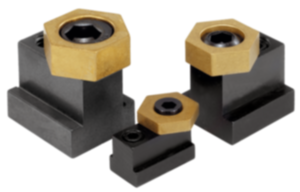Výkyvné opěrky / přítlačné šrouby
Self-aligning pads and thrust screw by KIPP
Thrust screws are operating parts and are often used as mechanical components. By turning them, they exert or transmit force. Thrust screws are ideal for pressing or carefully clamping threaded spindles, axles, shafts and treated surfaces. The operating elements consist of a threaded rod and a handle or head on which the rotary movement is carried out.
Self-aligning pads are special operating elements as well. They are used in fixtures to enable movements and transmit forces. These fixtures are used in mechanical engineering, construction and related technical disciplines. The term is made up of ‘self-aligning’ [pendulum] (for a reciprocating movement) and ‘pad’ (for a supporting device). These pads are designed to allow a pendulum-like movement, which means that they can move back and forth or swing in a restricted manner. In fixture construction, self-aligning pads are used as stops, supports and thrust pads.
Thrust screws and self-aligning pads are two important fastening elements that are used in industry and production in different applications. Thrust screws provide secure fastenings and allow for precise adjustments, while self-aligning pads ensure flexibility and vibration damping. Both fastening elements contribute significantly to the improvement of accuracy, stability and durability of machines and systems.
Thrust screws for clamping
Advantages of thrust screws
Ball-end thrust screws
Self-aligning pads for stabilisation
KIPP: Your expert for locating element
Thrust screws for clamping
Thrust screw may be used for different applications. They are often used in clamping fixture to hold workpieces in place. Turning the screw exerts compressive force that holds the workpiece securely in place. In machines and devices, on the other hand, thrust screws are used for precise positioning. The thread allows for the position to be adjusted and fastened very accurately. Thrust screws can also be used to transmit forces.
The operating principle of thrust screws is based on the conversion of rotary into linear movement. Thrust screws are made up of a threaded rod (screw shaft) and a head. The rotational movement performed on the threaded rod. By turning the head, the threaded rod is screwed into a corresponding thread. The rotary movement generates a linear movement along the axis of the threaded rod.
As the screw is turned, the counter thread is either pulled towards the screw head or pushed away from it. This movement generates compressive force on the workpiece, which is clamped between the screw head and the counter thread.
In clamping fixtures, the workpiece is firmly clamped between two surfaces by tightening the pressure screw. The pressure generated ensures that the workpiece is held securely in place and does not slip during processing or transport.
The thread pitch of the thrust screw determines how fine an adjustment can be made. A smaller thread pitch allows for more precise adjustment of position or pressure, as a smaller linear movement is generated for each rotation of the handle. In some applications, thrust screws are used to transmit great force. Due to the mechanical advantages of the thread, a comparatively small torsional force can be converted into a large axial compressive force. This is particularly useful in fixtures that require a high clamping force.
So it's no wonder that thrust screws can be found in applications such as vices, clamping elements and precision mechanical devices. Thanks to their simple but effective operating principle, thrust screws are essential elements in many areas of mechanics and manufacturing. Besides standard thrust screw the KIPP range includes the following styles:
- Stainless steel thrust screws
- Thrust screw with thread lock
- Thrust screws with radiused half-dog point
- Thrust screws with point
Advantages of thrust screws
Thrust screws offer a number of advantages that make them crucial components in many applications.
- Precise transmission of force: Thrust screws enable controlled and precise transmission of forces. This capability is particularly important for applications that require high accuracy.
- Easy handling: The use of thrust screws is pretty straightforward. The required force or position can be adjusted by simply turning the handle or head.
- High clamping force: Thrust screws can generate large clamping forces by converting the movement.
- Wide range of applications: Thrust screws are available in many different sizes, materials and designs, allowing for them to be used in a wide range of applications and industries.
- Fine adjustment: Thanks to their thread pitch, thrust screws allow for very fine and precise adjustment, making them ideal for applications that require exact positioning.
The combination of precision, versatility, durability and ease of use make thrust screws an indispensable tool in many a technical and industrial applications. Their ability to transmit great forces precisely and their adaptability to different requirements make them unique and valuable components.
Ball-end thrust screws
Ball-end thrust screw are a particular type of thrust screws. Whilst thrust screws apply constant pressure on their counter part, ball-end thrust screw allow for increased friction and high power transmission.
Thrust screws have a flat or slightly convex end that allows for pressure to be distributed evenly. This is used in various mechanical engineering applications for precise pressure application.
Ball-end thrust screws feature a ball at their tip that fits into the recess in the counter part. This allows ball-end thrust screws to distribute pressure more evenly on uneven or inclined surfaces, reducing the risk of damage and improving durability of components. The ball also ensures more precise and gentle application of pressure, making it ideal for applications where these properties are required.
KIPP's product range includes many different ball-end thrust screws. Ifball-end thrust screw with a head made of stainless steel or ball-end thrust screw without a head, the product range includes 12 different styles of these operating parts.
They differ in material, mounting and contact face, size and length.
Self-aligning pads for stabilisation
Self-aligning pads are used for stabilisation. They act as stops, supports and thrust pads to ensure positioning and fastening of workpieces.
One example of the application of self-aligning pads is their use in assembly devices. There, they are used to fasten components in the correct position during assembly processes. They prevent unwanted movements and enable precise alignment, which increases efficiency and quality of production. In the automotive industry, self-aligning pads are often used in the production of body parts. Self-aligning pads are also used in metalworking, for example when milling or turning workpieces. Here, they not only support fastening, but also precise machining by reducing vibrations and movements that could affect the quality of the end product.
Self-aligning pads offer industries a number of advantages that make them essential components in different production processes. A major advantage lies in their ability to limit and control movements. This is particularly important when machining large workpieces, where unwanted vibrations could affect precision and quality of the work.
In addition, self-aligning pads help increase stability during the production process. They ensure that workpieces are held securely in place. That not only improves safety of the working environment but also reduces the risk of damage to any material. Another significant advantage is improved precision. By precisely positioning and fastening parts in the required alignment, self-aligning pads allow for more accurate machining. This is particularly important in fields such as automotive and aerospace industries, where compliance with strict tolerances and dimensional specifications is crucial for the performance and safety of the end products. Last but not least, self-aligning pads support efficiency of production processes. They facilitate the workflow by reducing the time required for manual adjustment or fastening of workpieces. This enables companies to increase production capacity, simultaneous reducing production cost.
The KIPP range offers 12 different self-aligning pads. Besides standard-self-aligning pads it also includes self-aligning pads with O-ring, automatically swivelling self-aligning pads and adjustable supports.
A particular highlight are the two self-aligning pads with swivel angle. The self-aligning pad with swivel angles of 12°, 14° and 20° feature the following properties and characteristics.
- Swivelling self-aligning pads: The self-aligning pads are designed so that the can be pivoted. This allows for flexible adjustment and better distribution of the load forces to different swivel angles.
- Absorption of high load forces: The design of the self-aligning pads is sturdy and constructed for the absorption of high load forces. What are the advantages here? High stability and reliability in use, even under difficult conditions.
- Built-in O-ring: Every self-aligning pad features an O-ring that prevents dirt and foreign particles from entering the mechanism. This ensures the function of the self-aligning pad and supports a longer service life.
Thanks to the swivelling design these particular self-aligning pads offer a high degree of flexibility, load-bearing capacity and ability to absorb large load forces.
KIPP: Your expert for locating element
Die HEINRICH KIPP WERK GmbH & Co. KG is a leading manufacturer of locating elements, clamping and operating parts. With many years of experience in various industries, we stand for quality, reliability and innovation.
There are many reasons why you should purchase pressure screws and pendulum supports from KIPP. Firstly, we offer a wide range and many customisation options. Our thrust screw and self-aligning pads are available with different contact faces and diameters so that you are able to find exactly the right product for your requirements. The mounting and contact faces are available in various styles such as ribbed, beaded, flat, rough, round and pointed to meet the different needs of our customers.
Another advantage is that our products are available with different swivel angles. Swivel angles of 12°, 14° and 20° allow you to perfectly adjust the self-aligning pads to your specific requirements. This flexibility and efficiency are crucial for the improvement your applications.
Whether in production or quality control, we set the highest quality standards.
Choosing KIPP, means you are choosing a reliable partner with many years of experience, a wide range of products as well as a high level of commitment to quality and customer satisfaction.
